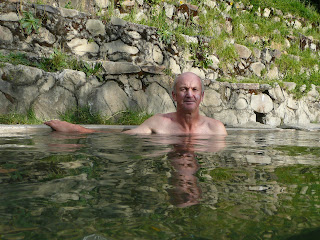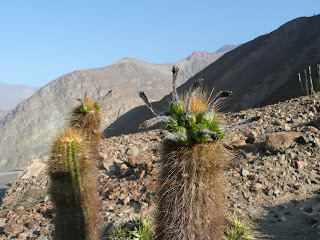
I took this same road in 1985, hitching on the back of trucks and I remember the smell of eucalypts along the way. Now they are the dominant vegetation on the sierra. Here eucalypts are being harvested destined for houses in Lima. I spoke with the foreman. The owner will get 10,000 soles (or $A4000) per hectare. The workers are paid 15 soles ($A6) a day plus 3 meals. Imagine Gunns operating on this scale in Tasmania. It would really slow down their rapacious destruction of our old growth forests, wouldn´t it?

The road from San Marcos to Huamachuco
The road really deteriorated 12kms out of San Marcos. It varied from a hard bumpy surface with lots of large stones and small ball-bearing pebbles, to a sticky muddy track. It was a slow and tough ride.



The Not-So-Lonely Road
In the South American Footprint guidebook, they write that the Cajamarca-Huamachuco road was a rough ride and "especially lonely for cyclists". Well I was never really alone. Lots of indigenous campesinos walking along the road, often with animals. I chatted to people working in the fields or in the small tiendas (where I bought soft drinks). Once I came across some women sitting under a tree selling strawberries. I bought half a kilo for 1 peso (40 cents) and ate them all on the spot! The indians of this part of the sierra are very welcoming..no shouts of `Gringo!´- instead it´s `Buena suerte amigo´ (from the men) or `Buenos tardes señor´ (from the children). As the road climbed higher onto the puna (3500m), the scenery became wilder and more dramatic. Up here on the sierra, the women here wear more traditional clothes and the houses are made of adobe and tiles. I felt I was finally in the Andes of my imagination and remembrances of things past.


Laguna Saucacocha 3150m, 12kms outside Huamachucho

Huamachuco market





The road out of Huamachuco started out quite nicely but as it climbed onto the broad plateau towards a 4200m pass it turned into a morass of mud and rocks.

What made the day worse.......at the top of the pass I realised there was another less travelled road, meandering up the opposite valley heading to Mollepata. So I had to drop steeply for 800m to meet this minor road and climb 1000m over a second pass.

The mountains around here are very rich in gold and two large mines have scarred the landscape, slicing the tops of the Andes and disembowelling the earth. I took this photo from my campsite at 4100m - in the distance is the Comarsca mine.

The following day I travelled up and down the mountainous terrain of a sparsely populated area, only encountering people in the small towns - the hills and valleys were deserted and silent.
The road from Mollepata to Pallasca dropped steeply into the Tablachaca valley and then climbed up the other vertical canyon wall in a scribbling set of zigzags, over 30 in all. I didn´t make it to Pallasca that day but camped on a narrow ledge at bend 19 (luckily I carried water up from the river).

The view from my camp (Bend 19) looking down to the Tablachaca river.

The road was in terrible shape- steep gradients, large stones and fine dust. In the late afternoon and with the sun on my back I pushed the bike up most of the way.

Pallasca town perched on a ridge 1500m above the Tablachaca canyon. A remote and lovely town of friendly people and amazingly, broadband internet!

Landscape around Pallasca region- dairy farms and self-seeding eucalypts (a human-assisted Gondwanan link).

The hospedaje where I stayed in Huandoval (almost pronounced as `Wonderful´)- a quaint, friendly little place in the remote sierra of Ancash province.

El carne - Peruvian sierra style. In Huandoval I was invited to a party by a prominent local family welcoming their son back from New York. A cow was slaughtered in the backyard...
and lots of beer was flowing, a local brass band playing.....

Cow´s head soup

Chicken foot soup

Lagunas Pusacocha - the lakes above Huandoval at 4200m.



I had climbed into an high valley at 4300m so I scaled some cliffs to access the next valley and to see Lagunas Pusacocha (or 9 lakes in Quechuan). The descent on the other side looked tricky but seemed possible. But halfway down I got into some real difficulty with wet mossy cliff faces. Twice I had to drop my bag with camera and GPS over steep ledges to get down. Finally made it...luckily no damage to gear.
Here is a view from below of the descent- harder than it looks.

The Chusgon hot springs 500m above Huandoval. I had 2 dips in the warm waters, before and after my hike into the lakes. Had it all to myself here at 5pm.

Trout Fishing in Peru
The last of 9 lakes had a small trout hatchery. I met Gaston, the young Quechuan entrepeneur who had set up the hatchery later that night in Huandoval and got into all sorts of problems with the Spanish language. I confused the word 'trucha' (meaning trout) with 'chucha', the rude term for the female sexual organ. The whole village thought this was hilarious, especially the women. I just had to put on my silly embarrassed gringo face and take the taunts, which you can just imagine.

The lads at Huandoval, who loved my fishing tales. In classic Peruvian style we drank beer outside the shop from a single glass, passing it around in a circle with a "Salud" to the next drinker.

Family at restaurant in Ancos. I had a bad fever on my descent from the sierra and the kind woman in the photo gave me some medicine and cooked me up 2 bowls of delicious chicken soup.

A long descent on a paved road from the lush green sierra down to dry cactus canyon country. The transition in landscape is dramatic and stark.



From Chuquicara to Huallanca along the Rio Santa, the road was in terrible shape and I was worried about the widening crack in the rear rim. So I put the bike on top of a bus for the 100km journey up the Santa valley. The bus almost rolled here as it tried to navigate around a truck stuck in the mud.

Cañon del Pato - 35 tunnels in 10kms. The road cuts its way through the narrow canyon. The chasm is only 15 metres wide in some places, the Rio Santa slicing its way between the twin cordilleras, the Cord. Blanca and Cord. Negra. Unfortunately very little water flows down the river now as most of it is diverted for hydro electricity (courtesy of Duke Energy).

The light at the end of the tunnel..or is it just tunnel vision? A bit scary as they are unlit and the surface is rough gravel.

Vagamundo bar in Huaraz. My namesake. The best pisco sours in northern Peru!

Another cracked rim. Velocity is slowing me down..putting another Spaniard in the works. I´m very pissed off with the quality of these rims and I would urge cyclists not to use Velocity Cliffhangers on expedition rides like this. There is an obvious design fault in the sidewall construction.

Arturo and the team at Huaraz bike shop. He replaced my cracked rim with an Alex downhill rim. Hope it holds out until a quality replacement arrives with Jude in Cuzco (going with the Sun Rhyno lite this time).




















